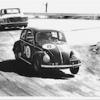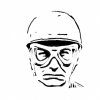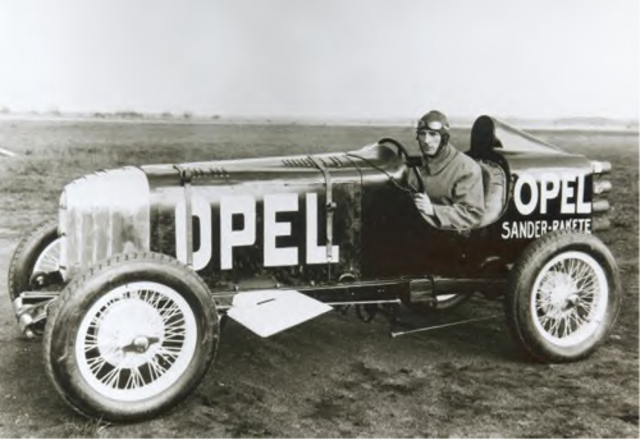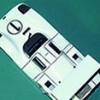Received wisdom - first use of a spoiler
#1

Posted 28 January 2016 - 20:21
Growing up down under, received wisdom from who knows where was that Richie Ginther invented the rear spoiler while at Ferrari, I had thought on the 250 GTO, or one of the early 60s sports car championship.
However I have just looked at an old auction notice for the 1955 Indy Car Streamliner built for Bill Vukovich. Apparently it had an adjustable rear spoiler, grief erred to at the time as an elevator.
Can some please (re)educate me? When was a rear spoiler first used? Or come to think of it, a front air dam? Another 'fact' lodged in my brain was that the first production car with one was a later version of the Lotus Europa. Wrong too?
Regards
Glenn
Advertisement
#2

Posted 28 January 2016 - 20:35
Perhaps the confusion comes from first use in F1, or Indy or Sportcars, etc. Each was independent of the other perhaps?
Surely once the Wright Brothers did their thing someone thought of wings on cars.
#3

Posted 28 January 2016 - 20:42
#4

Posted 28 January 2016 - 21:11
What is the difference between a spoiler or a flap?
More pertinently, why did McLaren and Lotus use Mini vans to test aero constructions? Chance, car in the yard?
#5

Posted 28 January 2016 - 21:14
The '68 Corvette had an inbuilt spoiler, it would have been released in late '67 so would readily have predated that second series of Europa.
#6

Posted 28 January 2016 - 22:12
Without trying too hard on the production car front...
The '68 Corvette had an inbuilt spoiler, it would have been released in late '67 so would readily have predated that second series of Europa.
As did the '68 Charger.
#7

Posted 28 January 2016 - 22:26
I recall asking the question a couple of years ago: Did any GT car use a spoiler prior to the GTO and nobody was able to find anything earlier. Porsche and Mercedes both used spoilers at LeMans during the early fifties of course...
#8

Posted 28 January 2016 - 22:37
In 1911, Ray Harroun won the Indy 500, sporting what he reckoned was a rear view mirror. I think it was really a 'wing'. ![]()
http://justacarguy.b...s-500-race.html
#9

Posted 28 January 2016 - 23:08
In 1911, Ray Harroun won the Indy 500, sporting what he reckoned was a rear view mirror. I think it was really a 'wing'.
I got to see the car again last May, on race day at "the 500." Even that picture doesn't do justice how huge that mirror was!
I don't have an answer, but I am curious if perhaps a spoiler was tried either by Auto Union or Mercedes in the 30s, or perhaps a "Champ Car" on American soil earlier than might be expected?
In any event, maybe I missed it, but did we clarify whether we are only looking for a sportscar spoiler? And, if we are only looking at sportscar spoilers, should we rule out air-brakes? It may sound ridiculous to bring up the air-brake thing, but I'm just wondering if there were any air-brakes that looked suspiciously like a wing? (I can't recall what the 1955 Le Mans air-brake car looked like).
#10

Posted 28 January 2016 - 23:15
#11

Posted 29 January 2016 - 01:08
Ferrari used tail spoilers on their 250TR and Dino sports racers in 1961, predating the 250GTO which came in 1962.
#12

Posted 29 January 2016 - 03:09
Originally posted by GMACKIE
In 1911, Ray Harroun won the Indy 500, sporting what he reckoned was a rear view mirror. I think it was really a 'wing'.
http://justacarguy.b...s-500-race.html
Huh?
It's the wrong shape, it's really quite small and it's obvious he had the rear view mirror purpose at the forefront.
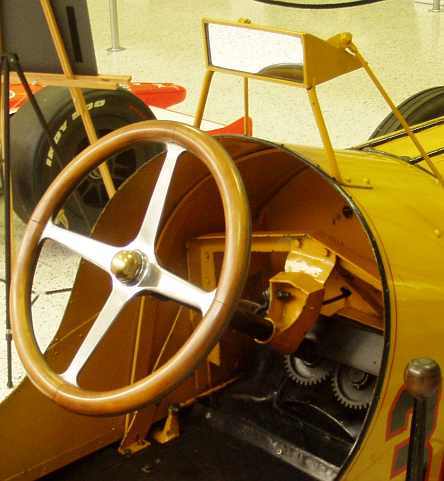
#13

Posted 29 January 2016 - 08:09
Huh?
It's the wrong shape, it's really quite small and it's obvious he had the rear view mirror purpose at the forefront.
I would say that the mirror inspired Colin Chapman to build the Lotus 56.
#14

Posted 29 January 2016 - 08:19
... however, it does establish that folks were messing about with distinct aero elements/wings as early as the 1920s.
Indeed - even vacuum-assisted traction (a la Chaparral 2J) was considered (theoretically at least - and a patent applied for) in the mid-twenties.
#15

Posted 29 January 2016 - 12:43
I think you need to be more specific. Air dam, spoiler, aerofoil, wing, etc, they can all describe quite different aero' appendages
#16

Posted 29 January 2016 - 13:48
I suppose the question really relates to cars or parts of them designed to induce downforce.
At Brooklands, most cars were streamlined - at least to the extent that their builders understood the principles. Most were shaped to be as thin as possible to "cut the wind". However, some were definitely "wedge" shaped. Can fairing in the dumb irons be considered an air dam? I suppose the question is really whether any had "designed" aero appendages.
The Voisin and Benz Tropfenwagen both had conscious aerodynamic input which again may well have included trying to provide downforce.
#17

Posted 29 January 2016 - 16:34
I think the OP is mainly concerned about a raised section or spoiler at the extreme rear of a sports or GT body, quite simple really, and that's what most of us regard as a spoiler. If we stretch the definition to include shaped mirrors and things like 1920s & 30s dumb iron fairings, possibly a legitimate extension in some ways, but we're just going to cause confusion.
#18

Posted 29 January 2016 - 17:07
Looks like I should have been more specific, my apoologies. Still, lots of interesting thoughts!
To me a spoiler is a part of the bodywork intended to reduce lift at the rear of the car, as opposed to a wing, which has air flowing below and above.
A front air dam is intended either to reduce air flowing under the car, or if angled, to produce some sort of downforce. Again, not a wing (or a mirror...)
Both devices seemed to me to be a step change in how air was treated by the magicians Kamm, Sayers and Costin. They are bolt-ons, fighting the air rather than trying to keep out of its way...
That Moss and Fangio discovered they could use the Mercedes air brake as a downforce creator is a credit to them, but not sure it falls into the spoiler category, if you accept the definition above?. I didn't realise Porsche were running spoliers at Le Mans in the 50's? Must do some searching
What always intrigued me about the Ginther story, if true, was simply that his suggestion was even taken onboard by the designers (Carlo Chiti?). I can't imagine that would be the case in every team, especially a european team listening to an american. I wonder if Colin Chapman knew about Jim Clark's experiment with a helicopter wing in the Tasman Series (On the other hand he presumably paid a lot of attention to Mario Andretti's ideas.). It was also innovative, not something I have ever associated with Ferrari
Anybody got a production car with an air dam earlier than the Europa?
Regards
Glenn
#19

Posted 29 January 2016 - 19:18
As did the '68 Charger.
The 1964 Ferrari 275GTB pre-dated both the '68 Charger and '68 Corvette as a production car with an "inbuilt" spoiler
Edited by bill p, 30 January 2016 - 12:54.
Advertisement
#20

Posted 29 January 2016 - 23:37
I wonder if Colin Chapman knew about Jim Clark's experiment with a helicopter wing in the Tasman Series.
On Colin Chapman and Jim Clark's Tasman Series experimentation with a rear wing made from a section of a helicopter blade, I wasn't at Lotus at the time, but I was told some years later by a Team employee whose name I forget, that Jim and Colin discussed the matter on the phone before the race. Chapman still in the UK, never told them not to use the wing, merely advised caution. I was told that his main concerns were the method of attaching it to the car, and the weight of the thing, not sure if anyone realised that the time that it was in the wrong place to have much aerodynamic effect. One of ACBC's best qualities was that he encouraged and supported initiative and experimentation by Lotus employees. Some would say that one of his worst qualities was taking the credit for other peoples' ideas that turned out to be successful, but since he'd usually had considerable input into development of these ideas, it's not something that I think he can fairly be criticised for. He was an intuitive engineer the like I've never encountered elsewhere. He'd work out what you were doing, and either tell you you were wasting your time, or suggest ways in which you could make it work better, and in my experience, he was usually right.
#21

Posted 31 January 2016 - 22:13
Coming back to the original query, My understanding (or received wisdom) is that it was the 1961 rear-engine Ferrari Dino sports car that was getting a bit "squirrely" at higher speeds. Then Richie Ginther saw a photo showing the car with a decidedly tail-up attitude. He discussed it with Ferrari engineers and together they came up with the spoiler on the trailing edge of the bodywork.
Like many early aerodynamic innovations this was probably a combination of luck and intuition. As Richie had worked for Douglas Aircraft and served for two years national service in the US Air Force he would have had more understanding of aerodynamics than most drivers and racing car engineers.
#22

Posted 31 January 2016 - 23:03
Coming back to the original query, My understanding (or received wisdom) is that it was the 1961 rear-engine Ferrari Dino sports car that was getting a bit "squirrely" at higher speeds. Then Richie Ginther saw a photo showing the car with a decidedly tail-up attitude. He discussed it with Ferrari engineers and together they came up with the spoiler on the trailing edge of the bodywork.
Like many early aerodynamic innovations this was probably a combination of luck and intuition. As Richie had worked for Douglas Aircraft and served for two years national service in the US Air Force he would have had more understanding of aerodynamics than most drivers and racing car engineers.
That is also my belief. The story has been documented many times, so it is quite likely to be true. Not that somewhere sometime, an earlier car didn't have a lip on the rear deck, probably one did. But for a trend setting design for racing sports cars, I think the Ferrari example was the one which showed the way forward. Ginther's out of the box thinking has the ring of credibility to it; aerodynamics was certainly a black art at the time.
Edited by D28, 31 January 2016 - 23:46.
#23

Posted 01 February 2016 - 02:55
Porsche has claimed the 1972 ducktailed 911 Carrera RS 2.7 had the world's first rear spoiler on a production vehicle. See http://press.porsche.com/news/release.php?id=762
I know this thread is mainly on spoilers but, adding a little on wings, the first in international racing is often said to have been the one the Swiss brothers Michel (or Michael) and Pierre May had on their private Porsche 550 Spyder in practice for the 1956 Nurburgring 1000km.
They lapped exceptionally quickly, qualifying among the big cars, but the Porsche works team protested, claiming the wing obscured the vision of other drivers, and officials banned the device.
Michel May, an engineer, worked for Ferrari in the early 1960s, on fuel injection, and is believed to told the team about his experience with the wing. He's said to have got the idea from the Opel rocket car shown above.
Rob B
#24

Posted 01 February 2016 - 03:16

This 275 GTB/4 Ferrari surely predated the 72 Porsche; it is simply the first production car that came to mind. Others may be earlier with a rear spoiler.
Edited by D28, 01 February 2016 - 03:20.
#25

Posted 01 February 2016 - 03:51
I was just pointing out what Porsche claimed, not saying it was correct.
There were also the '68 Corvette and Charger mentioned above, though I think the Corvette's was small and "integrated". Don't know the Charger's.
Rob B
#26

Posted 01 February 2016 - 07:46
The 1961 sports/racing Ferraris had bodies by Fantuzzi featuring a nose similar to the single seaters of that year and a high flat tail. The end of the tail was cut off in a vertical panel. It seems that the tail generated significant lift, leading to the adoption of the spoiler. When tested, the cars had a high tail fin which was dropped by the time the cars first raced. I don't know whether the fin was part of the original design or adopted during early tests and later replaced by the spoiler.Coming back to the original query, My understanding (or received wisdom) is that it was the 1961 rear-engine Ferrari Dino sports car that was getting a bit "squirrely" at higher speeds. Then Richie Ginther saw a photo showing the car with a decidedly tail-up attitude. He discussed it with Ferrari engineers and together they came up with the spoiler on the trailing edge of the bodywork.
Like many early aerodynamic innovations this was probably a combination of luck and intuition. As Richie had worked for Douglas Aircraft and served for two years national service in the US Air Force he would have had more understanding of aerodynamics than most drivers and racing car engineers.
I think that the above applies to the front-engined Testa Rossas as well as the 246SP.
#27

Posted 01 February 2016 - 16:30
The 1961 sports/racing Ferraris had bodies by Fantuzzi featuring a nose similar to the single seaters of that year and a high flat tail. The end of the tail was cut off in a vertical panel. It seems that the tail generated significant lift, leading to the adoption of the spoiler. When tested, the cars had a high tail fin which was dropped by the time the cars first raced. I don't know whether the fin was part of the original design or adopted during early tests and later replaced by the spoiler.
I think that the above applies to the front-engined Testa Rossas as well as the 246SP.
I agree. Fitzgerald and Merritt in Ferrari Sports and grand Turismo Cars state unequivocally that "The now ubiquitous duck-tail spoiler was first used in competition by Ferrari at Sebrng in Mar 1961".This was developed first on the 246 SP and adapted to other models like the TR1-61s. They mention that Carlo Chiti had established the first wind tunnel at Ferrari and that he was experimenting with aerodynamics. Ginther was entered at Sebring with Von trips in the 246 SP, and I believe it was he who came up with the idea during testing.
#28

Posted 01 February 2016 - 16:59
Is that raised "spoiler" on the 275 GTB/4 Ferrari called a "Kamm Tail"?
#29

Posted 01 February 2016 - 17:18
Is that raised "spoiler" on the 275 GTB/4 Ferrari called a "Kamm Tail"?
No, I don't believe so. The Kamm tail existed for quite a few years previously and was a cut off tail minus the lip, or duck-tail spoiler seen here.
#30

Posted 02 February 2016 - 21:55
I was just pointing out what Porsche claimed, not saying it was correct.
There were also the '68 Corvette and Charger mentioned above, though I think the Corvette's was small and "integrated". Don't know the Charger's.
Rob B
The Charger's was integrated (as well as being barely there).
#31

Posted 02 February 2016 - 22:31
Concerning a racing car-borne wing intended to generate aerodynamic download don't forget the 1966 No 96 Eisert-Chevrolet "Batcar" which featured a large aerodynamic wing mounted above its engine bay. Search Revs Digital Library - try 1966 Indianapolis Raceway Park and Eisert "Batcar". Not a 'spoiler' but a 'downforce generator'...
DCN


